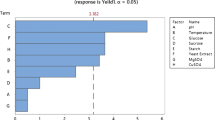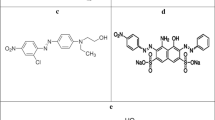Abstract
Screening of thirteen mushroom fungal isolates collected from Alagar Hill and Thandikudi Hill of Tamil Nadu, India, for laccase production revealed the high laccase production potential of the isolate MI 51. The mushroom isolate MI 51 was identified as Polyporus sp., based on sporophore (fruiting body) morphology and spore characteristics. Molecular identification of the fungal isolate MI 51 using primer ITS1 and ITS4 showed that isolate MI 51 shared 98 % sequence similarity with Polyporus arcularius, a basidiomycete fungus. Initial screening of production parameters using Plackett–Burman design helped in identifying the system variables/parameters which directly influenced laccase production. Laccase production by P. arcularius was optimized using central composite design (CCD) of experiments and response surface methodology (RSM) by studying influence of the growth supplements and media additives on modulating laccase production by P. arcularius. High laccase production by P. arcularius growing in basal salt medium, (9.30 IU/ml), was observed in 21 days of incubation. Results from experiments designed by CCD indicated that nearly threefold increase in laccase production (28.30 IU/ml) over the control experiments in basal salt medium could be obtained earlier at 15 days of incubation by increasing the content of the nitrogen source, yeast extract to 0.5 g/l, and by adding 250 μM CuSO4 to the basal salt medium. RSM plots showed high interaction between the variables, incubation time, yeast extract concentration, and CuSO4 concentration in the medium.
Similar content being viewed by others
References
Hatakka A.: Lignin-modifying enzymes from selected white rot fungi: production and role in lignin degradation. FEMS Microbiol. Rev. 13, 125–135 (1994)
Rodriguez E., Pickard M.A., Vazquez-Duhalt R.: Industrial dye decolorization by laccases from ligninolytic fungi. Curr. Microbiol. 38, 27–32 (1999)
Thurston C.F.: The structure and function of fungal laccases. Microbiology 140, 19–26 (1994)
Bourbonnais R., Paice M.G.: Oxidation of non-phenolic substrates. An expanded role for laccase in lignin biodegradation. FEBS Lett. 267, 99–102 (1990)
Bourbonnais R., Paice M.G.: Demethylation and delignification of kraft pulp by Trametes versicolor laccase in the presence of 2,29-azinobis-(3-ethylbenzthiazoline-6-sulphonate). Appl. Microbiol. Biotechnol. 36, 823–827 (1992)
Minussi R.C., Pastore G.M., Duran N.: Potential applications of laccase in the food industry. Trends Food Sci. Technol. 13, 205–216 (2002)
Couto S.R., Toca-Herrera J.L.: Industrial and biotechnological applications of laccases: a review. Biotechnol. Adv. 24, 500–513 (2006)
Puri S., Beg Q.K., Gupta R.: Optimization of alkaline protease production from Bacillus sp. by response surface methodology. Curr. Microbiol. 44, 286–290 (2002)
Balusu R., Paduru R.R., Kuravi S.K., Seenayya G., Reddy G.: Optimization of critical medium components using response surface methodology for ethanol production from cellulosic biomass by Clostridium thermocellum SS19. Process Biochem. 40, 3025–3030 (2005)
Wang Q., Ma H., Xu W., Gong L., Zhang W., Zou D.: Short communication: ethanol production from kitchen garbage using response surface methodology. Biochem. Eng. J. 39, 604–610 (2008)
Coninck D., Bouquelet J., Dumortier S., Duyme V., Verdier V., Denantes I.: Industrial media and fermentation processes for improved growth and protease production by Tetrahymena thermophila. J. Ind. Microbiol. Biotechnol. 24, 285–290 (2000)
Ghanem N.B., Yusef H.H., Mahrouse H.K.: Production of Aspergillus terreus xylanase in solid state cultures: application of the Plackett–Burman experimental design to evaluate nutritional requirements. Bioresour. Technol. 73, 113–121 (2000)
Dey G., Mitra A., Banerjee R., Maiti B.R.: Enhanced production of amylase optimization of nutritional constituents using response surface methodology. Biochem. Eng. J. 7, 227–231 (2001)
Aravindan R., Viruthagiri T.: Statistical experimental design for evaluation of medium components for lipase production by Rhizopus arrhizus MTCC 2233. LWT—Food Sci. Technol. 42, 985–992 (2009)
Avishek M., Arun G.: Enhanced production of exocellular glucansucrase from Leuconostoc dextranicum NRRL B-1146 using response surface method. Bioresour. Technol. 99, 3685–3691 (2008)
Xinjun Y., Ning G., Zhenming C., Fang G., Jun S., Zhe C.: Inulinase overproduction by a mutant of the marine yeast Pichia guilliermondii using surface response methodology and inulin hydrolysis. Biochem. Eng. J. 43, 266–271 (2009)
Deepak V., Kalishwaralal K., Ramkumarpandian S., Babu S.V., Senthilkumar S.R., Sangiliyandi G.: Optimization of media composition for Nattokinase production by Bacillus subtilis using response surface methodology. Bioresour. Technol. 99, 8170–8174 (2008)
Quaratino D., Ciaffi M., Federici E., D’Annibale A.: Response surface methodology study of laccase production in Panus tigrinus liquid cultures. Biochem. Eng. J. 39, 236–245 (2007)
Pratheebaa P., Periasamy R., Palvannan T.: Factorial design for optimization of laccase production from Pleurotus ostreatus IMI 395545 and laccase mediated synthetic dye decolorization. Ind. J. Biotechnol. 12, 236–245 (2013)
Radhika R., Roseline Jebapriya G., Joel Gnanadoss J.: Decolourization of synthetic dyes using the edible mushroom fungi Pleurotus. Pak. J. Biol. Sci. 17, 248–253 (2014)
Kaul T.N.: Biology and Conservation of Mushrooms. Oxford and IBH publishing Co. Pvt. Ltd., New Delhi (1997)
Ramakrishna G., Singaracharya M.A., Lakshmipathi V.: Effluent treatment by white rot fungus Stereum ostrea. Ind. J. Microbiol. 44(2), 121–124 (2004)
Das N., Sengupta S., Mukherjee M.: Importance of laccase in vegetative growth of Pleurotus florida. Appl. Environ. Microbiol. 63, 4120–4122 (1997)
Steffen K.T., Hofritchter M., Hatakka A.: Purification and characterization of manganese peroxidases from the litter-decomposing basidiomycetes Agrocybe praecox and Stropharia coronilla. Enzyme Microb. Technol. 30, 550–555 (2002)
Graham G.C., Mayer P., Henry R.J.: A simplified method for the preparation of fungal genomic DNA for PCR and RAPD analysis. Biotechniques 16(1), 48–50 (1994)
Altschul S.F., Gish W., Miller W., Myers E.W., Lipman D.J.: Basic local alignment search tool. J. Mol. Biol. 215, 403–410 (1990)
Saitou N., Nei M.: The neighbor-joining method: a new method for reconstructing phylogenetic trees. Mol. Biol. Evol. 4(4), 406–425 (1987)
Plackett R.L., Burman J.P.: The design of optimum multifactorial experiments. Biometrika 33, 305–325 (1946)
Tukayi K., Gibson S.N., Georg M.G., Stephanie B.: Potential applications of laccase-mediated coupling and grafting reactions: a review. Enzyme Microb. Technol. 48, 195–208 (2011)
DeJong E., De Vries F.P., Field J.A., Van Der Zwan R.P., De Bont J.A.M.: Isolation and screening of basidiomycetes with high peroxidative activity. Mycol. Res. 96, 1098–1104 (1992)
Luterek J., Gianfreda L., Wojtas-Wasilewska M., Rogalski J., Jaszek M., Malarczyk E., Dawidowicz A., Finks-Boots M.: Screening of the wood-rotting fungi for laccase production: induction by ferulic acid, partial purification, and immobilization of laccase from the high laccase producing strain Cerrena unicolor. Acta Microbiol. Pol. 46, 297–311 (1997)
Coll P.M., Abalos J.M.F., Villanueva J.R., Santamaria R., Perez P.: Purification and characterization phenoloxidase (laccase) from the lignin degrading basidiomycete PM1. Appl. Environ. Microbiol. 59, 2607–2613 (1993)
Kiiskinen L.L., Ratto M., Kruus K.: Screening fr novel laccase-producing microbes. J. Appl. Mlcrobiol. 97, 640–646 (2004)
Vishwanath B., Chandra M.S., Pallavi H., Reddy B.R.: Screening and assessment of laccase producing fungi isolated from different environmental samples. Afr. J. Biotech. 7(8), 1129–1133 (2008)
Ravikumar K., Pakshirajan K., Balu K.: Optimization of batch process parameters using RSM for dye removal by a novel adsorbent. Chem. Eng. J. 105, 131–138 (2005)
Karuppaiya M., Sasikumar E., Viruthagiri T., Vijayagopal V.: Optimization of process conditions using response surface methodology for ethanol production from waste cashew apple by Zymomonas mobilis. Chem. Eng. 196, 1425–1435 (2009)
Sasikumar E., Viruthagiri T.: Simultaneous saccharification and fermentation of sugarcane bagasse in Kinetics and modeling. Chem. Eng. 19, 145–148 (2010)
Riswan Ali S.B., Muthuvelayudham R., Viruthagiri T.: Enhanced production of cellulase from tapioca stem using response surface methodology. Innov. Romanian Food Biotechnol. 12, 40–51 (2013)
Sharma P., Singh L., Dilbaghi N.: Optimization of process variables for decolorization of Disperse Yellow 211 by Bacillus subtilis using Box–Behnken design. J. Hazard. Mater. 164, 1024–1029 (2009)
Eggert C., Temp U., Eriksson K.E.: The ligninolytic system of the white rot fungus Pycnoporus cinnabarinus: purification and characterization of the laccase. Appl. Environ. Microbiol. 62, 1151–1158 (1996)
Kaal E.E.J., Field J.A., Joyce T.W.: Increasing ligninolytic enzyme activities in several white rot basidiomycetes by nitrogen sufficient media. Bioresour. Technol. 53, 133–139 (1995)
Vinoth Kumar V., Dinesh K., Periyaraman P., Sivanesan S.: Screening and induction of laccase activity in fungal species and its application in dye decolorization. Afr. J. Microbiol. Res. 5(11), 1261–1267 (2011)
Galhaup C., Haltrich D.: Enhanced formation of laccase activity by the white-rot fungus Trametes pubescens in the presence of copper. Appl. Microbiol. Biotechnol. 56, 225–232 (2001)
Shutova V.V., Revin V.V., Makushina Y.A.: The effect of copper ions on the production of laccase by the fungus Lentinus (Panus) tigrinus. Appl. Biochem. Microbiol. 44, 683–687 (2008)
Author information
Authors and Affiliations
Corresponding author
Rights and permissions
About this article
Cite this article
Jegatheesan, M., Eyini, M. Response Surface Methodology Mediated Modulation of Laccase Production by Polyporus arcularius . Arab J Sci Eng 40, 1809–1818 (2015). https://doi.org/10.1007/s13369-014-1499-3
Received:
Accepted:
Published:
Issue Date:
DOI: https://doi.org/10.1007/s13369-014-1499-3




